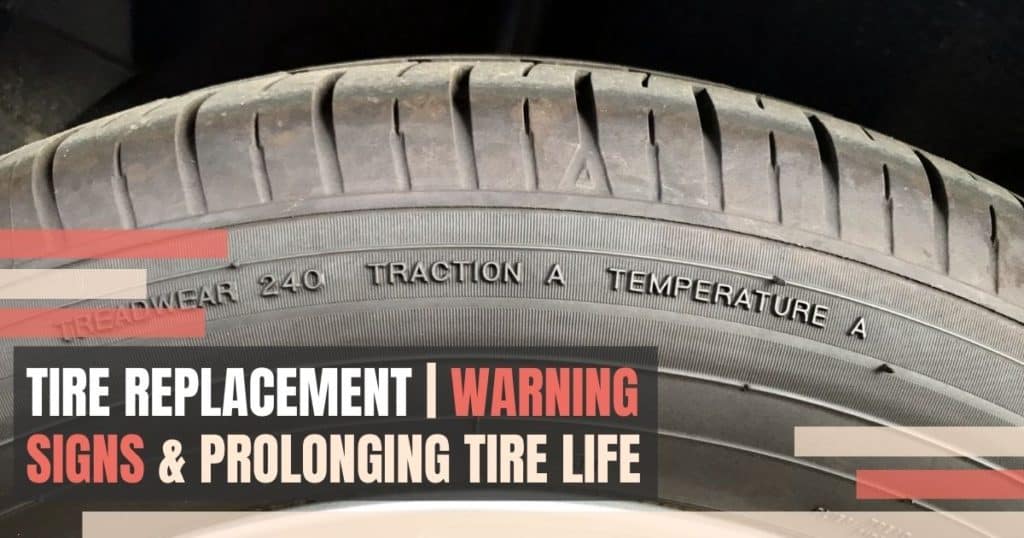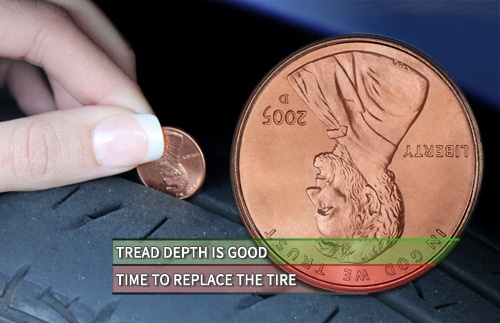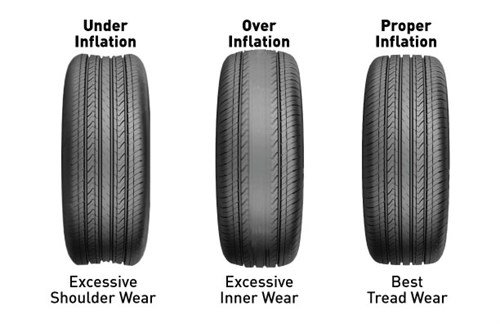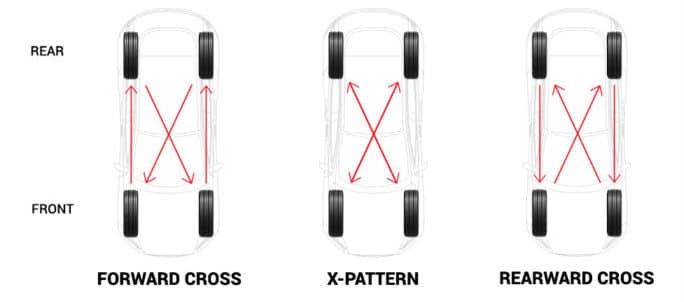After a few days on the road, brand new tires can look grimy, grey, and worn. So how in the world are you supposed to know when it’s time to get new ones? Below is a basic guide to understanding the natural lifespan of your tires. No one wants to spend money on a tire replacement, when they don’t need one…and you also don;t want to wait until it is too late!
How to Determine When a Need Tire Replacement
In general, there are three basic things to think about if you are worried your tires need to be replaced:
- Tread wear
- Tire age
- Extreme temperature exposure
Worn treads essentially loosen your tires’ “grip” on the road. It can make your car unsafe to drive, especially in rain or snow. If you’re not sure how worn your treads are, you can perform an easy check with a penny or quarter. Simply insert the coin (with the president’s head facing down) into one of the grooves in your tire. If you can still see the top of Lincoln or Washington’s head, it’s probably time for a tire replacement.
Wear and tear can sometimes be hard to see or feel in your tires, so it’s recommended to replace your tires every six years. There is a date code on the side of your tire, that tells you when the tire was manufactured. After six years the chemical compounds in the rubber degrade and cause structural issues.
You may think that you live in a mild climate, but long-term exposure to the heat of the sun can cause your tires to warp and sustain internal, structural damage. The same is true for exposure to extreme cold, especially if that cold is coupled with ice and snow.
To learn more about how to evaluate a tire, read this for safety, read here. It’s also helpful to look at your tires UTQG rating if you have a passenger car and are curious about it’s tread wear, temperature resistance, and traction ratings.
5 Signs You Need a Tire Replacement
There are some warning signs to watch for that may indicate it’s time to replace your tires.
1. Low Tread Depth Less then 2/16th of an Inch
The first is shallow tread depth. A safe tread depth is generally considered to be at least 2/16th of an inch (that’s 2.6 millimeters for folks using the metric system). You can check your tread depth with a ruler, a gauge, or by inserting a penny into the tread. Anything lower then 2/16’s is considered legally bald.
2. The Tread Wear Indicator Bars are Showing
Newer tires are also built with tread wear indicator bars. These small bars appear on the tire as flat rubber lines that run perpendicular to the tire’s tread pattern. These lines are nearly invisible when the tire is new, but slowly become more and more pronounced as the tread becomes worn. You can see the indicator highlighted in red in the picture.
3. Cracks in the Sidewall
Cracks in the sidewall are a big indicator that it’s time for a tire replacement. This kind of damage cannot be fixed with a simple patch or plug. Any damage to the sidewall is considered dangerous and will effect the structure of the tire.
4. Bulges or Bubbles in the Rubber
Bulges or bubbles are another sign that your tire is no longer safe to drive on. These often occur on the sidewall when extreme weather conditions are present. If you see any of these signs these are serious indicators of tire replacement.
5. Vibration While Driving
Pay attention to how your car feels on the road. A lot of vibration, especially at high speeds, can indicate that something is wrong with your tires or your rims. It could also mean you require a brake service or a tire balancing.
4 Tips on How to Prolong Tire Replacement
There are some routine maintenance services that, if you build into the overall care of your car, can extend the lifespan of your tires.
1. Check Air Pressure
The first is performing a monthly check on your tire’s air pressure. Driving around on slightly deflated tires or over inflated tires may not seem like a big deal, but can cause internal damage to the tire’s structure. This cannot be repaired. Additionally it will cause your tires to wear faster and in strange spots.
2. Rotate Frequently
A very important maintenance routine is to get your tires rotated every 5,000 miles. The weight distribution across the body of your car is not even, and so the weight on your front tires is different from the weight on your back tires. A tire rotation essentially swaps the front and back tires to ensure even tire wear across all four tires. Failing to rotate your tires can cause one set of tires to wear more quickly than the others, which will not only shorten the lifespans of the worn tires, but can cause all four tires to be thrown out of balance.
3. Ensure They Are Balanced
Because of this, after a tire rotation, you should also make sure that your mechanic does a balance check on your tires, as imbalanced tires can also wear at uneven rates and can sometimes cause damage to your car’s suspension system.
4. Semi Annual Alignment
Finally, doing an alignment check twice a year is a preventative measure to catch alignment problems before they do extensive damage to your tires.
How Long Do Car Tires Normally Last?
The ideal lifespan for a tire is six years and it is recommended to replace it no matter what condition it’s in. Even a tire that’s never been mounted, shouldn’t be used if it’s older then six years. Most tires last about four years, especially if you are driving around 15,000 miles a year on them. It’s important to note that the tread often wears down before the rubber compound, which is why rotations and balance checks do so much to extend your tire’s lifespan.
Even if you drive much less than 15,000 miles per year, it’s recommended that you get new tires after six years. Old tires can deteriorate to the point that they are dangerous to drive on. This is why it’s recommended that you immediately replace the tires after you’ve bought a used car. Unless the seller can provide receipts to date when the tires were purchased, get a tire replacement. You should also be cautious when buying used tires and understand the basics.
Tire age is such a problem for tires is that they are made of rubber and chemical compounds. Old rubber is far more prone to cracking than new rubber. The same is true of the rubber on your tires. So even if they have good tread and haven;t not been driven on, driving around on old rubber is a dangerous gamble.
Options for Tire Replacement
Often times money becomes the biggest factor in determine the best replacement option. Your primary choices are new or used and then how much are you willing to spend. High end new tires like a set of Goodyear Eagles can run you over $500 new. Alternatively you can find a used set with plenty of mileage left for about 35 to 50% off. The most imporatnt factor to consider though is size and rating when picking a replacement tire.
Replacing One vs Replacing All
There are certain situations when it can make sense to replace one tire. If your other tires are almost new or you are at the end of a lease, replacing one makes sense. From a financial stand point replacing one makes a lot of sense. You don’t want to sepnd money for four tires when you may only need one. The challenges come later when you only replace one tire. What happens is the new tire will have a different tread depth then there others creating different braking, accelerating, and corning abilities. For more on this topic, read here.
Special Case for Run Flats Tire Replacement
Run flats also present a unqiue situation for tire replcement. 70% of all run flat tire manufacturers recommend replacing all 4 tires when one needs a replacement. Given that run flats are more expensive, it can get pretty pricey especially on a vehicle like a BMW or Mercedes. There are tire shops that will only follow the manufacturers recommendations and push you to replace all four even if you just ask for one. That is because they will be liable if they don’t follow the manufacturer. For more info on run flats, read here.
Tire Replacement – Conclusion
Just because a tire is expensive doesn’t mean it’s the best. Remember these big companies spend a lot of money on marketing, which inflates the price and perception of their products. There are plenty of new tire options you can find for about $75 per tire that will get you a great set of rubbers. Going used, you may be able to get name brand tires for less, you just need to ensure they are safe. Never choose to save money and sacrifice safety.






